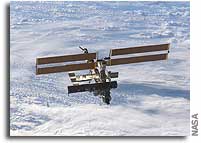ISS On-orbit Status 19 Jan 2003

All ISS systems continue to function nominally, except as noted previously
or below. Ahead: Week 8 for Expedition 6.
Sunday, and 2nd weekend rest day for the crew, but…never a dull moment.
FE1-Nikolai Budarin, assisted by his crewmates, had a very busy schedule,
dominated by Vozdukh troubleshooting. [After preparing for the checkout
of the CO2 scrubber’s suspected VN vacuum pump and demating its BITS2-12
internal telemetry connection, he was to remove the pump for a series
of measurements of electrical resistance between pump connector terminals/pins
with the portable ohmmeter. Depending on the measurement results, after
consultation with MCC-M/TsUP, he then was to install either a new spare
pump or reinstall the old pump for further troubleshooting ahead. If
successful, Vozdukh was to be activated, in automatic cycle mode. The
VN pump moves air from the CO2 absorption cartridges into the station
atmosphere to minimize air loss before vacuum regeneration of each of
the two filters. The VN can reduce the cartridge’s pressure down to 50
mmHg, and its operation is monitored by observing the residual pressure
in the cartridge.]
Budarin also performed the weekly readings of the SVO water supply status
counter as well as SP urine collection and pretreat assembly inspection
and toilet flush counter for calldown to MCC-M/TsUP via S-band, followed
by the weekly daily routine inspection of the water processor’s BRPK
air/condensate separator system.
Later, Budarin completed the Russian BIO-5 Rasteniya-2/Lada-2 ("Plants-2")
plant growth payload, then terminated the 24-hr. regeneration cycle for
adsorbent bed #2 of the BMP harmful impurities filtration unit. Both
filter channels are now back in Purify mode.
Nikolai also performed the daily routine maintenance of the SOSh life
support system, while FE-2/SO Don Pettit prepared the daily IMS inventory
database file for automatic update import/export.
Pettit then collected his two daily CO2 readings in Lab and SM using
the CDMK (carbon dioxide monitor kit).
FE-1 Budarin was scheduled for a televised PFC (private family conference)
to TsUP via K-band and S-band. PFCs were also scheduled for CDR Ken Bowersox
and Don Pettit, via audio/S-band.
All crewmembers performed their daily physical exercise.
The crew was congratulated on an excellent R&R job yesterday, when
they removed and replaced an O2 (oxygen) regulator in the U.S. Airlock.
[The ground requested further clarification of an observation by Pettit,
who, after the R&R, had mentioned a "knick" on the surface
of the discharge line from the regulator, apparently referring to the
secondary sealing surface of a Gammah fitting in the line.]
Questions were also uplinked to Don regarding problems he encountered
on 1/17 with the TOCA (total organic carbon analyzer). [The questions
are intended to help clarify the circumstances surrounding an error message
that popped up after Pettit had set up the TOCA reagent mix, and which
he was unable to clear up before stowing the equipment. TOCA is a water
quality monitoring instrument for determining concentrations of total
organic carbon, total inorganic carbon, total carbon, pH value and conductivity
in water.]
CDR Bowersox was thanked for his assistance and inputs during I6 processing
runs of the ZCG (Zeolite crystal growth) experiment, which he completed
yesterday with the deactivation of the ZCG furnace heaters. [His observations
from the clear autoclaves, and suggestions for coalescing bubbles, were
most welcome to payload scientists, who are now keen on seeing if fewer
nucleation points indeed yields some of their best science yet.]
POC (Payload Operations Center) reported to Bowersox that his EXPRESS
Rack 5 (ER5) software load on 1/17 for the ELC (ER5 laptop computer)
and RIC (rack interface controller) was successful, but that POC afterwards
did not see ER5 health and status properly, necessitating a software
change. [Analysis of a command log file sent down by Sox showed the cause
to be a software glitch (improper setting of an IP address) which will
be corrected prior to the planned software loading of ER4 on 1/24. Loading
of ER1 tomorrow, 1/20, will not be affected.]
MCC-M/TsUP is planning Progress M1-258 (9P) propellant transfer (fuel
and oxidizer) to the ISS Russian segment next week (probably 1/23).
Today’s targets for the CEO (crew earth observations) program were Manaus
region, Brazil (Dynamic Event. Clear weather in the Amazon basin. A mapping
swath of the multiple waterways of the Negro River [second largest on
the planet] requested. The Negro dug a canyon in inner Amazonia during
the last ice age. This canyon is now filled with young sediment with
so many islands that the region is known locally as the "archipelago".
Looking left for highly sensitive sunglint mapping views of the Negro
and its poorly mapped tributaries), Buenos Aires, Argentina (nadir view;
ESC [electronic still camera]),and Patagonian Glaciers (detailed views
of the highly dynamic lower ends of glaciers coming off the Andes Mountains
are requested. Looking left and right of track).
CEO images can be viewed at the website
http://eol.jsc.nasa.gov
ISS Orbit (as of this morning, 6:31am EST [= epoch]):
Mean altitude — 389.4 km
Apogee — 393.3 km
Perigee — 385.5 km
Period — 92.34 min.
Inclination (to Equator) — 51.64 deg
Eccentricity — 0.0005711
Orbits per 24-hr. day — 15.59
Altitude loss — 170 m (mean) in last 24 hours
Revolutions since FGB/Zarya launch (Nov. ’98) — 23780
For more on ISS orbit and worldwide naked-eye visibility dates/times,
see
http://www.hq.nasa.gov/osf/station/viewing/issvis.html








